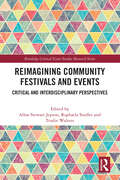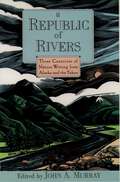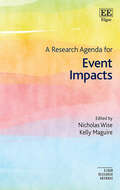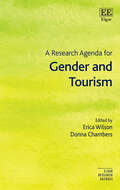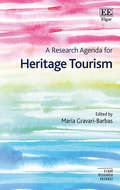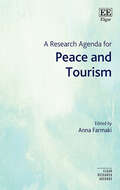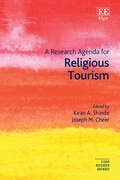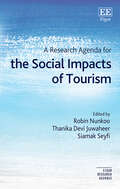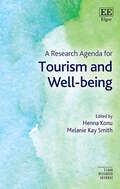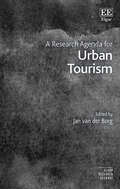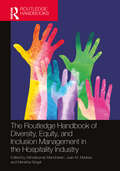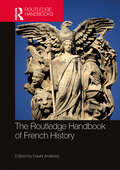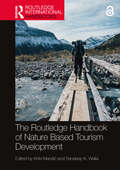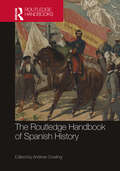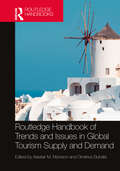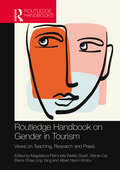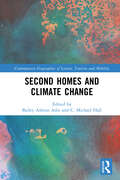- Table View
- List View
Reimagining Community Festivals and Events: Critical and Interdisciplinary Perspectives (ISSN)
This book celebrates and builds on Alan Clarke (1956–2021) and Allan Jepson’s 2015 book Exploring Community Festivals and Events. It showcases how far the study of community festivals and events has come in the intervening years, and in so doing it is a response to recent calls for researchers to take a more critical approach to event studies.This is an interdisciplinary book that draws together empirical research across a wide range of community event types, sizes and within diverse communities. Chapters in this book are grouped into four themes that highlight the breadth and depth of work being done: reviving and maintaining tradition(s); a focus on belonging; challenges and tensions; and innovations in teaching and research. Another of its core strengths is its international perspective – the book encompasses research from around the world including Turkey, Portugal, Greece, India, the UK, the US, Austria and New Zealand. There is also a diverse range of theoretical lenses applied to the study of community events, and some innovative methodologies used to achieve research aims and objectives.This volume will appeal to students and researchers in the fields of critical event studies, cultural studies, place-making, tourism, music, sociology and geography. Several chapters also provide insights and key learnings for those lecturing and working in event management and industry professionals.
A Republic of Rivers: Three Centuries of Nature Writing from Alaska and the Yukon
"The spell of Alaska," Ella Higginson wrote in 1908, "falls upon every lover of beauty who has voyaged along those far northern snow-pearled shores...or who has drifted down the mighty rivers of the interior which flow, bell-toned and lonely, to the sea....No writer has ever described Alaska; no one writer ever will; but each must do his share, according to the spell that the country casts upon him." In A Republic of Rivers, John Murray offers the first comprehensive anthology of nature writing in Alaska and the Yukon, ranging from 1741 to the present. Many of the writers found here are major figures--John Muir, Jack London, Annie Dillard, Barry Lopez, and Edward Abbey--but we also discover the voices of missionaries, explorers, mountain-climbers, Native Americans, miners, scientists, backpackers, and fishermen, each trying to capture something of the beauty of this still pristine land, to render in their own words the spell that the country casts upon them. The range of viewpoints is remarkable. With Annie Dillard we look out at ice floes near the remote Barter Island and see "what newborn babies must see: nothing but senseless variations of light on the retinas." With Frederick Litke we mourn the senseless slaughter of sea mammals. We join scientist Adolph Murie, the father of wolf ecology, as he probes the daily life of an East Fork wolf pack. And we listen as Tlingit Indian Johnny Jack relates the difficulty of maintaining a dignified life close to nature at a time of cultural upheaval for his people. Most of these selections have never appeared in any anthology and some entries--particularly those written by early American and Russian explorers--have never been available to general readers. There is laughter here and there is sorrow, but finally there is communion and liberation as generation after generation encounter the unsurpassed beauty and wildness of the Arctic. Taken together, these forty-nine men and women provide a unique portrait of America's final frontier.
A Research Agenda for Event Impacts (Elgar Research Agendas)
Elgar Research Agendas outline the future of research in a given area. Leading scholars are given the space to explore their subject in provocative ways, and map out the potential directions of travel. They are relevant but also visionary.Exploring the social, economic and environmental impacts of events on people, places and communities, this timely Research Agenda highlights the links between theory and practice in event impacts research. Top scholars critically assess events, looking at who benefits from hosting them, and focusing on issues surrounding sustainability, the need to define legacies, and the need to extend regeneration efforts to secure economic and socially sustainable futures.The Research Agenda first outlines key theories and concepts in the field, addressing the three impacts recognized in triple bottom line considerations of sustainability. Chapters then move to analyse a range of types and scales of event, including: conventions and business events, sports tourism, cultural and religious events, intangible cultural heritage, and events in rural locations. This forward-looking Research Agenda further analyses event hosting in emerging economy nations, disability access and inclusion, climate change and the impact of the Covid-19 pandemic.Covering a broad range of types, scales and settings of events, this will be a crucial read for event studies and event management scholars. The critical insights to practical impacts of events will also be beneficial for policy-makers and event practitioners.
A Research Agenda for Gender and Tourism (Elgar Research Agendas)
Elgar Research Agendas outline the future of research in a given area. Leading scholars are given the space to explore their subject in provocative ways, and map out the potential directions of travel. They are relevant but also visionary. Forward-looking and innovative, Elgar Research Agendas are an essential resource for PhD students, scholars and anybody who wants to be at the forefront of research.Original and thought-provoking, this Research Agenda investigates the many ways in which tourism is gendered. It outlines current thought and directions for future research, looking forward by imagining and challenging the ways that gender will continue to intersect with and impact on tourism, as well as looking back to trace the key developments and contributions in gendered thinking.Chapters consider and rethink gender in the context of tourism from multiple vantage points, contexts and perspectives. Divided into three parts, the Research Agenda reflects key threads in a contemporary research agenda: gender theory, analysis and review; gender, tourism and work; and gendered tourism experiences. Bringing together a range of diverse and inclusive contributions, it moves beyond binary assumptions of ‘women’ and ‘men’ towards the intersectionalities among gender, race, class, sexuality and power in relation to tourism.Highlighting emerging research in the field, along with the methods and paradigms that are at the forefront of gendered tourism research, this Research Agenda will be an invigorating read for critical tourism researchers as well as gender researchers and those in the social sciences more broadly.
A Research Agenda for Heritage Tourism (Elgar Research Agendas)
Elgar Research Agendas outline the future of research in a given area. Leading scholars are given the space to explore their subject in provocative ways, and map out the potential directions of travel. They are relevant but also visionary. This timely Research Agenda moves beyond classic approaches that consider the relationship between heritage and tourism either as problematic or as a factor for local development, and instead adopts an understanding of heritage and tourism as two reciprocally supported social phenomena that are co-produced. Chapters draw on case studies from Europe, North America and Asia, offering important insights on heritage consumption, hypercommodification, war tourism, dissonant heritage, decolonizing heritage and the rising importance of the digital world of tourism. The book commences with a global overview on the changing paradigm of heritage tourism, before focusing on heritage and tourism at different scales and the impacts of globalization on heritagization. It also examines the political nature of tourism heritage construction and the experiential turn of heritage tourism practices. An invigorating read for students and scholars of tourism and heritage studies, this book offers a multitude of suggestions for pathways for future research. It is also a timely read for those working with heritage sites and looking to better understand the intersection between heritage and tourism.
A Research Agenda for Peace and Tourism (Elgar Research Agendas)
Elgar Research Agendas outline the future of research in a given area. Leading scholars are given the space to explore their subject in provocative ways, and map out the potential directions of travel. They are relevant but also visionary.This highly prescient Research Agenda critically examines the delicate intersection of peace and tourism and proposes further research in order to explore how tourism may contribute to peace or, conversely, hinder the peacebuilding efforts of destinations in conflict.Anna Farmaki brings together a wealth of expertise from scholars who present the peace and tourism nexus from a variety of different perspectives, using both empirical evidence and conceptual research to support cases. Chapters discuss tourism as a peace-builder, the acceptance of dark tourism, a gender approach to peace through tourism, and corporate social responsibility as a contributor to peace in conflict-ridden situations. This innovative and forward-thinking Research Agenda provides a vital contribution to this burgeoning area of research, carrying implications for local communities, tourist destinations and wider society at large in conjunction with the UN’s 2030 Sustainable Development Agenda.Providing a much-needed re-examination of the connection between peace and tourism, this book will prove essential reading for students, academics and researchers interested in human geography, political geography and geopolitics, tourism management and business and management. Considering many practical outcomes of tourism policy, this book will also benefit professionals working in tourism, foreign policy, public policy and international relations.
A Research Agenda for Religious Tourism (Elgar Research Agendas)
Elgar Research Agendas outline the future of research in a given area. Leading scholars are given the space to explore their subject in provocative ways, and map out the potential directions of travel. They are relevant but also visionary.Incisive and interdisciplinary, this Research Agenda broaches topics that have been under-researched within religious tourism, including: place attachment and marketing; memory and modification of sacred landscapes for tourism needs; the darker sides of religious tourism; multi-stakeholder governance; mission-trips; and allied forms of tourism.With contributions from top scholars, the book includes cases from across Europe and Asia, exploring pilgrimage sacred landscapes for different religions. Building on emerging themes including the importance of governance, conflicts associated with pilgrimage and religious tourism, gender and gendered dimensions, resilience in the wake of the recent pandemic, and newer ways of performing religious tourism such as virtual reality, it sets a research agenda for future inquiry.This thought-provoking Research Agenda will be a valuable resource for scholars of tourism, human geography, heritage studies, anthropology, and religious studies.
A Research Agenda for the Social Impacts of Tourism (Elgar Research Agendas)
Elgar Research Agendas outline the future of research in a given area. Leading scholars are given the space to explore their subject in provocative ways, and map out the potential directions of travel. They are relevant but also visionary.This timely Research Agenda explores the crucial need to understand the social impact of tourism in order to manage industry growth sustainably. Highlighting the multifaceted nature of tourism, chapters uncover the intricate relationships between tourists and host communities and investigate this complex social fabric. Bringing together a diverse array of international perspectives and research approaches, it covers governance for sustainable tourism, resident attitudes towards tourism, the impact of local lodging on residents’ perceptions of tourism, and the social implications of COVID-19. Using an interdisciplinary lens, this Research Agenda advocates for the need to move beyond a positivist paradigm and to adapt current tourism strategy in order to create effective sustainable tourism practices. Contributors propose a new approach which emphasizes the significance of theoretical and methodological foundations in studying social impacts, aiming to capture the tourist and host community nexus in all its complexity and depth.This Research Agenda will be an essential resource for students, academics, and researchers specializing in tourism, urban planning, human geography, and sociology. It will also prove insightful for industry practitioners and policymakers seeking a comprehensive understanding of the social dynamics and implications of tourism, as well as those interested in addressing and mitigating the negative impacts of tourism.
A Research Agenda for Tourism and Wellbeing (Elgar Research Agendas)
Elgar Research Agendas outline the future of research in a given area. Leading scholars are given the space to explore their subject in provocative ways, and map out the potential directions of travel. They are relevant but also visionary.Interdisciplinary and multidimensional in its approach, this insightful Research Agenda critically analyses the principal issues that have emerged in recent years from tourism and wellbeing studies. It provides a detailed analysis of definitions and key concepts and explores the research agenda related to product and service development, motivation, segmentation and management using established as well as experimental methodologies.Enlightening contributions from leading scholars detail the role, indicators, and measurement of wellbeing in tourism economics, expertly examining issues of individual wellbeing and how experiences of wellbeing can be facilitated for both employees and tourists. The various impacts of tourism on wellbeing are analysed from a diverse range of perspectives, including collective experiences of social and diasporic tourism and individual experiences of wellbeing and transformation.Succinct and cutting-edge, A Research Agenda for Tourism and Wellbeing will appeal to students, academics, and researchers in tourism, sociology, economics, business, psychology, and human geography. It will also prove insightful to practitioners involved in product and service development, tourism and destination, marketing and human resources management sectors.
A Research Agenda for Urban Tourism (Elgar Research Agendas)
Elgar Research Agendas outline the future of research in a given area. Leading scholars are given the space to explore their subject in provocative ways, and map out the potential directions of travel. They are relevant but also visionary.This timely Research Agenda explores and proposes critical lines of research to support understanding of the conditions under which urban tourism contributes to the development of urban systems, and what can be done to create and conserve these conditions. Chapters highlight conceptual discussions, concrete case studies and policy reviews to address the issues surrounding the economic, environmental and social impacts of tourism on cities.Analysing the trends that have characterized urban tourism in the past, the Research Agenda looks ahead to those that may influence it in the future, including the impact of Covid-19. Chapters further offer a thorough conceptualization and innovative definitions of the phenomenon of urban tourism. The critical issue of the sustainability of tourism development in cities is also discussed in depth.The Research Agenda provides a comprehensive and up-to-date overview of the urban tourism debate, making it a critical read for urban studies and tourism scholars. The detailed case studies from across four continents will also be beneficial to policymakers and urban planners dealing with tourism development.
The Routledge Handbook of Diversity, Equity, and Inclusion Management in the Hospitality Industry
Interdisciplinary in terms of both its coverage and contributions, The Routledge Handbook of Diversity, Equity, and Inclusion Management in the Hospitality Industry provides an informative and systematic guide to the current state of knowledge on workforce diversity and its management. Providing empirical knowledge and reflective practice on diversity issues and their management in the hospitality industry, this handbook includes chapters written by a plethora of experts in the diversity management (DM) field, including scholars, academics, and industry experts, such as managers from leading hospitality industry firms. Logically structured and embellished with illustrative figures throughout, the volume provides critical reviews and an appraisal of current research and the future development of conceptual and theoretical approaches to diversity, equity, and inclusion (DEI) management in the hospitality industry, including dimensions of diversity in hospitality, such as gender, cultural/ethnic, age, disability, sexual orientation, and Indigenous workers. Elucidative examples are used from different countries such as Australia, Austria, Canada, Japan, United Arab Emirates, and India, and the volume takes a solution-based approach, providing future directions for emerging diversity researchers. Global in perspective, this book is a pivotal teaching resource for academics, an illustrative reference resource for Ph.D. students and early career researchers who work on workforce diversity and a practical guide for managers and HR consultants. It will also appeal to wider audiences, including those in tourism, recreation and leisure studies, and other professional fields.
The Routledge Handbook of French History
Aimed firmly at the student reader, this handbook offers an overview of the full range of the history of France, from the origins of the concept of post-Roman "Francia," through the emergence of a consolidated French monarchy and the development of both nation-state and global empire into the modern era, forward to the current complexities of a modern republic integrated into the European Union and struggling with the global legacies of its past.Short, incisive contributions by a wide range of expert scholars offer both a spine of chronological overviews and a diverse spectrum of up-to-date insights into areas of key interest to historians today. From the ravages of the Vikings to the role of gastronomy in the definition of French culture, from Caribbean slavery to the place of Algerians in present-day France, from the role of French queens in medieval diplomacy to the youth-culture explosion of the 1960s and the explosions of France’s nuclear weapons program, this handbook provides accessible summaries and selected further reading to explore any and all of these issues further, in the classroom and beyond.
The Routledge Handbook of Nature Based Tourism Development (Routledge International Handbooks)
This handbook offers a comprehensive overview of the themes and concepts related to nature-based tourism development. Providing interdisciplinary insights from leading researchers, academics, and practitioners across the globe, it delivers a critical and timely contribution to the knowledge around nature-based tourism. Nature-based tourism is currently the fastest-growing tourism sector globally and for many destinations, the most significant tourism segment. Organized into five parts, this handbook provides contemporary and cutting-edge perspectives on core topics and explores their linkages. It considers, among others, various natural settings and natural attractions where nature-based tourism can be exercised, including: protected and conserved areas, islands, and mountains; the emerging themes shaping the contemporary nature-based tourism development, including ethics, Sustainable Development Goals, COVID-19 crisis, over-tourism, climate change, resilience; and new approaches toward the visitor management and low-impact experience design, including regenerative and transformative tourism, destination stewardship and pro-environmental behaviour. Part I introduces the concept of nature-based tourism and the emerging challenges in the field. Part II explores the key components in the management and planning of nature-based tourism development. In Part III the handbook focuses on visitor experience design and management and Part IV highlights the impacts of nature-based tourism. Part V examines the future of nature-based tourism and possible solutions to mitigate associated challenges in the field. The handbook offers a valuable contribution with a systematic outlook of the phenomenon of nature-based tourism and critical perspectives on key concepts, policy, and practice. It shares current knowledge, innovative tools, and sustainable solutions with substantial evidence and societal impact. The book will appeal to students, researchers, and professionals in the fields of tourism, human geography, leisure studies, business studies, and sociology.
The Routledge Handbook of Spanish History
This handbook offers comprehensive coverage of the history of Spain, exploring key themes and events in four broad but not necessarily rigid temporal categories: medieval, early modern, nineteenth century and twentieth century. The volume situates Spanish history firmly within the broader patterns unfolding across the European continent, emphasizing Spain’s active participation in the processes that determined the development of modern European society. With chapters from leading scholars from both Spanish and international universities, the book helps fill long-standing gaps in European history. This handbook provides original contributions on broad themes in Spanish history which are also accessible syntheses of the most recent scholarship. Making the latest research in Spanish history more widely accessible to an international audience, The Routledge Handbook of Spanish History is an essential reference point for students and scholars of Spain, as well as those working in comparative European history.
Routledge Handbook of Trends and Issues in Global Tourism Supply and Demand
This Handbook provides a comprehensive overview of trends and issues in the global supply and demand on tourism. With contributions from 70 authors, this Handbook showcases a diverse range of perspectives with insights from around the globe. It reviews the interactions among trends and issues, and it emphasises the importance of tracking and interpreting these on a global scale. The book is organized into three parts, with Part I focusing on supply-side trends including transport, attractions, culture, heritage tourism, technology, policies, and destination management. Part II critically reviews the external factor trends, including the impact of terrorism, multi-crisis destinations, Generation Z’s important contributions to the sector, the regulation of sharing economy platforms and nature tourism in future. Part III focuses on market-led trends such as bleisure, glamping, VFR travel, transformational tourism and new trends in wellness tourism following the post-COVID era. The book also provides predictions for the upcoming decades. This Handbook will be a vital tool for researchers, students, and practitioners in the tourism and hospitality sector to further develop their knowledge and expertise in the field. It examines business and policy implications, offering guidance for developing sustainable competitive advantage.
Routledge Handbook on Gender in Tourism: Views on Teaching, Research and Praxis
This comprehensive handbook delves into the multifaceted dimensions of the role of gender in tourism, spanning education, research, and practice. With 40 international contributions from leading thinkers in the field, this book brings together diverse themes such as entrepreneurship, mobility, sustainability, and sexuality. In doing so it shatters traditional boundaries and dissects how gender influences perceptions, experiences, and opportunities, advocating for equality and challenging entrenched power dynamics. Informed by the United Nation's Gender Equality goals, this handbook champions the potential of gender-aware tourism to reshape the world by fostering inclusivity, empowerment, and understanding. It adopts diverse insights, encompassing feminist and queer perspectives, challenging norms, and exploring marginalised voices. By dissecting gender in educational, entrepreneurial, and research contexts, it unveils hidden dynamics. This book empowers readers to grasp the breadth of gender's role and equips them with tools to foster equality and reshape the tourism landscape, while making suggestions for future research agendas.This book is intended for scholars, educators, researchers, government officials and practitioners in the fields of gender studies, tourism, education, entrepreneurship, employment, mobility, research, sustainability, and sexuality.
Saturn V Rocket (Large Print)
This is an image of the Saturn V rocket: the type that carried American astronauts on the various Apollo missions to the moon in the 1960s and '70s. There is a locator dot shown, which will be at the top left of the page when the image is the right way up. The rocket is seen from the side moving diagonally from the bottom left of the page to the top right. It was 354 feet (108 metres) high and consisted of four stages, the last of which landed on the moon. At the bottom left of the page are the first stage rocket engine's exhaust gases pushing the vehicle through the atmosphere. Up and right from this are three of the five first stage engine outlets. Moving up and to the right are the rest of the rocket stages; they are marked by lines across the width of the launch vehicle. The fine textured section at the top right of the page is the spacecraft. This carried the astronauts and the lunar module, which travelled to and landed on the moon. The pointed section at the very top was the LES (launch escape system)
Saturn V Rocket (UEB Contracted)
This is an image of the Saturn V rocket: the type that carried American astronauts on the various Apollo missions to the moon in the 1960s and '70s. There is a locator dot shown, which will be at the top left of the page when the image is the right way up. The rocket is seen from the side moving diagonally from the bottom left of the page to the top right. It was 354 feet (108 metres) high and consisted of four stages, the last of which landed on the moon. At the bottom left of the page are the first stage rocket engine's exhaust gases pushing the vehicle through the atmosphere. Up and right from this are three of the five first stage engine outlets. Moving up and to the right are the rest of the rocket stages; they are marked by lines across the width of the launch vehicle. The fine textured section at the top right of the page is the spacecraft. This carried the astronauts and the lunar module, which travelled to and landed on the moon. The pointed section at the very top was the LES (launch escape system)
Saturn V Rocket (UEB Uncontracted)
This is an image of the Saturn V rocket: the type that carried American astronauts on the various Apollo missions to the moon in the 1960s and '70s. There is a locator dot shown, which will be at the top left of the page when the image is the right way up. The rocket is seen from the side moving diagonally from the bottom left of the page to the top right. It was 354 feet (108 metres) high and consisted of four stages, the last of which landed on the moon. At the bottom left of the page are the first stage rocket engine's exhaust gases pushing the vehicle through the atmosphere. Up and right from this are three of the five first stage engine outlets. Moving up and to the right are the rest of the rocket stages; they are marked by lines across the width of the launch vehicle. The fine textured section at the top right of the page is the spacecraft. This carried the astronauts and the lunar module, which travelled to and landed on the moon. The pointed section at the very top was the LES (launch escape system)
Second Homes and Climate Change (Contemporary Geographies of Leisure, Tourism and Mobility)
This book is the first to address the important interrelationship between second homes and climate change, which has become an increasingly relevant issue for many regions around the world. Second homes are often a key source of tourist visitation as well as economic benefit for their host communities. The chapters provide an array of international case studies and climate change impacts, including the changing biocultural landscapes in Italy, hazard risks in the mountains of Poland, and the shifting media discussion on second homes and climate change in Finland. Topics covered focus on issues around planning and governance in second home locations, adaptation and mitigation measures implemented by second home owners, and the influence of second home owners’ place attachment in relation to second home impacts. It introduces the overall topic of second homes and climate change while also laying the groundwork for future work in this burgeoning area of research. This book will be of significant interest to upper-level undergraduates, graduate students, and academics in the fields of geography, tourism, planning, housing studies, regional development, environmental management, and disaster management. It would also be of use for professionals who engage with second home communities, particularly planners, government officials, and environmental officers.
Space Shuttle (Large Print)
This is a diagram of an American space shuttle, designed to carry large loads in an orbital path around the circumference of the Earth. There is a locator dot shown, which will be at the top left of the page when the image is the right way up. The shuttle is shown in two views: a plan view (seen from above) and a side view. The shuttle is carried into the upper atmosphere of the earth by SRBs (solid rocket boosters) and then continues under the power of its own engines. The plan view is in the top left part of the page. The nose cone of the shuttle is at the far left. Directly right of this is the cockpit window, the main body of the craft with the payload doors, the engine covers, the rudder, and the engines. The swept-back wings of the shuttle extend up and down the page from the main body. To the far right of the plan view the expelled gasses that push the craft through space can be found. The side view of the shuttle is in the bottom right of the page. At the left of the image is the nose cone with a landing wheel just down the page. Moving right is the main body of the craft with the payload doors at the top and the wings and rear landing wheel down the page. Further to the right two of the four engines are visible with expelled gasses at the far right. Slightly up the page is the rudder.
Space Shuttle (UEB Contracted)
This is a diagram of an American space shuttle, designed to carry large loads in an orbital path around the circumference of the Earth. There is a locator dot shown, which will be at the top left of the page when the image is the right way up. The shuttle is shown in two views: a plan view (seen from above) and a side view. The shuttle is carried into the upper atmosphere of the earth by SRBs (solid rocket boosters) and then continues under the power of its own engines. The plan view is in the top left part of the page. The nose cone of the shuttle is at the far left. Directly right of this is the cockpit window, the main body of the craft with the payload doors, the engine covers, the rudder, and the engines. The swept-back wings of the shuttle extend up and down the page from the main body. To the far right of the plan view the expelled gasses that push the craft through space can be found. The side view of the shuttle is in the bottom right of the page. At the left of the image is the nose cone with a landing wheel just down the page. Moving right is the main body of the craft with the payload doors at the top and the wings and rear landing wheel down the page. Further to the right two of the four engines are visible with expelled gasses at the far right. Slightly up the page is the rudder.
Space Shuttle (UEB Uncontracted)
This is a diagram of an American space shuttle, designed to carry large loads in an orbital path around the circumference of the Earth. There is a locator dot shown, which will be at the top left of the page when the image is the right way up. The shuttle is shown in two views: a plan view (seen from above) and a side view. The shuttle is carried into the upper atmosphere of the earth by SRBs (solid rocket boosters) and then continues under the power of its own engines. The plan view is in the top left part of the page. The nose cone of the shuttle is at the far left. Directly right of this is the cockpit window, the main body of the craft with the payload doors, the engine covers, the rudder, and the engines. The swept-back wings of the shuttle extend up and down the page from the main body. To the far right of the plan view the expelled gasses that push the craft through space can be found. The side view of the shuttle is in the bottom right of the page. At the left of the image is the nose cone with a landing wheel just down the page. Moving right is the main body of the craft with the payload doors at the top and the wings and rear landing wheel down the page. Further to the right two of the four engines are visible with expelled gasses at the far right. Slightly up the page is the rudder.
SpaceShipOne (Large Print)
This page shows an image of SpaceShipOne, designed to be the first non-government funded craft to reach the edge of space at just over one hundred kilometres. It was launched from a purpose-built aircraft, White Knight. There is a locator dot shown, which will be at the top left of the page when the image is the right way up. At the top centre of the page is the nose cone of the craft with many small round windows shown in a heavy texture. Down the page is the body of the plane and down again is the nozzle of the engine and the hot gases being expelled towards the bottom of the page. To the left and right of the body are the two wings. They are hinged so that their configuration can be changed for the climbing, gliding, and re-entry stages of flight.
SpaceShipOne (UEB Contracted)
This page shows an image of SpaceShipOne, designed to be the first non-government funded craft to reach the edge of space at just over one hundred kilometres. It was launched from a purpose-built aircraft, White Knight. There is a locator dot shown, which will be at the top left of the page when the image is the right way up. At the top centre of the page is the nose cone of the craft with many small round windows shown in a heavy texture. Down the page is the body of the plane and down again is the nozzle of the engine and the hot gases being expelled towards the bottom of the page. To the left and right of the body are the two wings. They are hinged so that their configuration can be changed for the climbing, gliding, and re-entry stages of flight.
